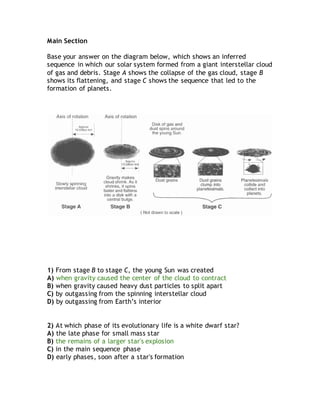
Star life cycles
- 1. Main Section Base your answer on the diagram below, which shows an inferred sequence in which our solar system formed from a giant interstellar cloud of gas and debris. Stage A shows the collapse of the gas cloud, stage B shows its flattening, and stage C shows the sequence that led to the formation of planets. 1) From stage B to stage C, the young Sun was created A) when gravity caused the center of the cloud to contract B) when gravity caused heavy dust particles to split apart C) by outgassing from the spinning interstellar cloud D) by outgassing from Earth’s interior 2) At which phase of its evolutionary life is a white dwarf star? A) the late phase for small mass star B) the remains of a larger star's explosion C) in the main sequence phase D) early phases, soon after a star's formation
- 2. 3) When a star less massive than our sun consumes all of its nuclear fuel it will then become a A) white dwarf B) nova C) supernova D) black hole 4) What factor from the choices below determines whether a star will evolve into a white dwarf, a neutron star, or a black hole? A) mass B) percentage of helium C) percentage of carbon D) apparent brightness 5) The probable fate of our sun is A) to expand as a red giant, undergo a nova outburst and end as a white dwarf B) to shrink to a white dwarf then eventually expand to a red giant C) become hotter and expand into a blue supergiant D) to become a black hole 6) Which stars are the youngest? A) Supergiant B) White dwarf C) Blue star D) Red Dwarfs Base your answer for questions 7 to 8 on the Luminosity and Temperature of Stars graph in the Earth Science Reference Tables. 7) In which group of stars would a star with a temperature of 5000°C and a luminosity of approximately 100 times that of the Sun be classified? red giants or giants 8) Describe the relationship between temperature and luminosity of main sequence stars. – As temperature increases, luminosity increases. – This is direct relationship 9) By using a spectroscope an astronomer can
- 3. A) measure the size of a star B) measure the altitude of a star C) identify elements in the atmosphere of a star D) measure the diameter of a star 10) The explosion of a massive star near the end of its life is known as a A) nova B) pulsar C) supernova D) nebula Base your answer for questions 11 to 12 on the star chart below, which shows part of the winter sky visible from New York State. Some of the brighter stars are labeled and the constellation Orion is outlined. 11) In the space below, list the stars, other than Bellatrix, found on the chart in order of decreasing luminosity Rigel, the most luminous star, has been listed.
- 4. 12) Identify the color of the star Bellatrix, which has a surface temperature of approximately 21,000°C. blue. Base your answer for questions 13 to 14 on on the passage below and on your knowledge of stars and galaxies. Stars Stars can be classified according to their properties, such as diameter, mass, luminosity, and temperature. Some stars are so large that the orbits of the planets in our solar system would easily fit inside them. Stars are grouped together in galaxies covering vast distances. Galaxies contain from 100 billion to over 300 billion stars. Astronomers have discovered billions of galaxies in the universe. 13) The star Betelgeuse is farther from Earth than the star Aldebaran. Explain why Betelgeuse appears brighter or more luminous than Aldebaran. Examples: –Betelgeuse is larger. –Betelgeuse is more massive than Aldebaran. –Aldebaran has less volume. 14) Complete the table by placing an X in the boxes that indicate the temperature and luminosity of each star compared to our Sun. 15) List the five stars below in order of decreasing relative luminosity, with letter a being the brightest. Aldebaran, Betelgeuse, Polaris, Sirius, the Sun Brightest: a. Betelgeuse b. Polaris c. Aldebaran d. Sirius e. the Sun Least Brigh
- 5. The Future of the Sun Hydrogen gas is the main source of fuel that powers the nuclear reactions that occur in the Sun. But just like many sources of fuel, the hydrogen is in limited supply. As the hydrogen gas is used up, scientists predict that the helium created as an product of earlier nuclear reactions will begin to fuel new nuclear reactions. When this happens, the Sun is expected to become a red giant star with a radius that would extend out past the orbit of Venus and possibly out as far as Earth’s orbit. Earth probably not survive this change in the Sun’s size. But no need to worry at this time. The Sun is not expected to expand to this size for a few billion years. 16) On the diagram of the planets and the Sun’s surface, draw a vertical line to represent the inferred location of the Sun’s surface when it becomes a red giant star. 17) Explain why a red giant star, similar to Aldebaran, has a greater luminosity than the Sun. Examples: – Aldebaran is larger than the Sun. – The Sun is smaller than Aldebaran. 18) Identify the nuclear reaction referred to in this passage that combines hydrogen gas to form helium and produces most of the Sun’s energy. Examples: – fusion – nuclear fusion 19) Complete the table by identifying the color and classification of the star Procyon B. The data for the Sun have been completed as an example.